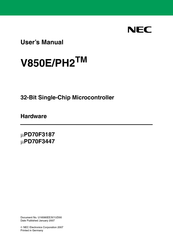NEC MuPD70F3187 Microcontroller Manuals
Manuals and User Guides for NEC MuPD70F3187 Microcontroller. We have 1 NEC MuPD70F3187 Microcontroller manual available for free PDF download: User Manual
NEC MuPD70F3187 User Manual (1053 pages)
32-Bit Single-Chip Microcontroller
Brand: NEC
|
Category: Microcontrollers
|
Size: 7.31 MB
Table of Contents
-
Preface
7 -
-
-
Outline33
-
Applications36
-
-
Features85
-
-
-
Images99
-
Memory Map101
-
Areas103
-
Cautions143
-
-
-
Features145
-
Bus Control Pins145
-
Bus Access151
-
Bus Width155
-
Wait Function174
-
-
Program Space180
-
Data Space180
-
-
-
-
-
Pin Status60
-
-
Features193
-
DMA Operation200
-
-
-
-
Features259
-
Function Outline259
-
Configuration260
-
Operation274
-
-
-
Features313
-
Configuration314
-
Basic Operation343
-
Match Interrupts364
-
Flags368
-
-
Error Interrupts380
-
-
PWM Mode402
-
-
-
Features457
-
Function Outline457
-
Configuration458
-
Basic Operation480
-
-
PWM Mode501
-
-
-
-
Features535
-
Function Outline535
-
Operation554
-
Basic Operation554
-
-
-
-
-
-
Features569
-
Configuration569
-
Operation572
-
-
-
Features573
-
Configuration574
-
Operation585
-
Basic Operation585
-
-
-
-
-
Precautions608
-
-
-
Features609
-
Configuration610
-
Operation626
-
Data Format626
-
Receive Error636
-
-
-
Baud Rate640
-
Baud Rate Error640
-
-
-
Features645
-
Configuration645
-
Operation655
-
Clock Timing664
-
Output Pins666
-
Operation Flow667
-
-
Configuration673
-
-
Cautions676
-
-
-
Features677
-
Configuration678
-
Operation695
-
Operation Modes695
-
Master Mode701
-
Slave Mode702
-
Single Mode703
-
Consecutive Mode705
-
Reception Mode707
-
Output Pins712
-
-
-
Cautions738
-
-
-
Features739
-
CAN Protocol742
-
Frame Format742
-
Frame Types743
-
Error Frame750
-
Overload Frame751
-
-
-
-
Bit Stuffing752
-
Multi Masters753
-
Multi Cast753
-
-
-
-
Single-Shot Mode829
-
Self-Test Mode829
-
-
Features865
-
Configuration865
-
Operation866
-
Access Timing866
-
-
-
-
-
Features971
-
Configuration971
-
Operation972
-
-
-
-
KEL Connector979
-
-
Precautions983
-
-
Features985
-
-
Pin Connection998
-
-
-
DC Characteristics1010
-
AC Characteristics1011
-
-
Interrupt Timing1017
-
-
Advertisement
Advertisement
